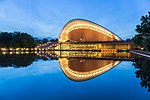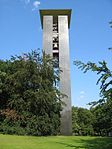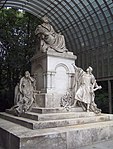Memorial to the First Homosexual Emancipation Movement

The Memorial to the First Homosexual Emancipation Movement (German: Denkmal für die erste homosexuelle Emanzipationsbewegung) is a memorial in the neighbourhood of Moabit in Berlin, Germany. Unveiled on 7 September 2017, the memorial is located opposite the Federal Chancellery on the Spree and commemorates the first homosexual movement, which was destroyed in 1933 by the Nazis, and especially the Scientific-Humanitarian Committee founded in 1897 to oppose the criminalization of homosexuality in Germany. The Scientific-Humanitarian Committee's headquarters were located on the other bank of the Spree near the Federal Chancellery. The riverbank where the memorial is located has been named the Magnus-Hirschfeld-Ufer since 2008. The memorial includes an information panel that has been in place since 2011 and discusses the movement with portraits of Anita Augspurg (1857–1943), Karl Heinrich Ulrichs (1825–1895) and Magnus Hirschfeld (1868–1935).
Excerpt from the Wikipedia article Memorial to the First Homosexual Emancipation Movement (License: CC BY-SA 3.0, Authors, Images).Memorial to the First Homosexual Emancipation Movement
Magnus-Hirschfeld-Ufer, Berlin Moabit
Geographical coordinates (GPS) Address External links Nearby Places Show on map
Geographical coordinates (GPS)
| Latitude | Longitude |
|---|---|
| N 52.5185 ° | E 13.36 ° |
Address
Denkmal für die erste homosexuelle Emanzipationsbewegung
Magnus-Hirschfeld-Ufer
10557 Berlin, Moabit
Germany
Open on Google Maps











